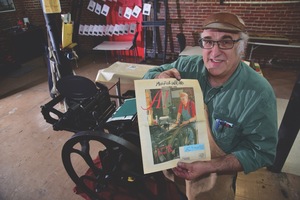

David Winship displays a copy of the September 1995 A! Magazine for the Arts that featured his father.
David Winship, adjunct professor of Appalachian studies and manager of the Sign of the George, is intimately connected to the letterpress shop.
His father, Dr. George Winship Jr., taught English at King University from the late "40s to the "80s. George's father, a bibliophile and rare books librarian at Harvard University, gave him a small hand letterpress and type when he was a child. They used it to print a small book, "How The Monkey Got Its Tail." They called their printing project the Sign of the George, since both of them were named George.
In 1974, Dr. Winship started the letterpress print shop at King. The Sign of the George first found its home in Anderson Hall. Originally a men's dorm, it sat vacant due to structural problems. Soon after opening the shop, Winship acquired an 8' x 12' Chandler & Price so heavy the floor had to be reinforced. That same year, George Winship personally purchased the contents of a fully equipped hobby print shop. Although it included dozens of sizes and styles of type, it contained only enough to print cards or labels - not enough for the small books Winship had in mind. Over the next several years, Winship supplemented this collection with purchases from flea markets and foundries.
The Sign of the George eventually relocated to its current home, the basement of the Women's Auxiliary Building. Prior to the print shop, this room contained the campus snack bar, the King's Den. The old grill hood remains in the print shop.
"They took the emblem of St. George slaying the dragon as a logo for the press," David Winship says. "The block of that logo, which is a metal cut, is what you see as the image for the press, which is now revived as The Sign of the George Press and Gallery, which will contain art work from King University also.
"Dad started the Sign of the George Press at King to both teach his students what early authors had to contend with in getting their work published, as well as publishing some of their own poetry, some classic public domain pieces of literature, and to do some work for campus individuals and organizations and events. This spring at Dogwood Festival/Alumni Weekend, we hope to work with the theater department and its Shakespeare production with a program or broadside.
"I've got ink in my veins from growing up in my teens and 20s here in the print shop. My father learned about printing from his father and passed it on to me. When I graduated from College of the Atlantic, a small school of human ecology I helped start in Bar Harbor, Maine, I delivered the commencement address. When I returned to Bristol after a year on the road doing community energy education and organizing, I settled in Jonesborough and set advertising ads at night for the Johnson City Press-Chronicle. This was a couple of generations of typesetting after linotype. But during the day I came home and would set the type of the commencement address. So at night I was at a keyboard at the paper, and by day I was in the shop handsetting the type. I felt I had my feet in two different eras, two different centuries. With the keyboard, I could set a couple of columns of type in minutes. At the print shop, it took days.
"My children and my brother also enjoy puttering in the shop when they are in town. I did a Christmas card for my brother that used one of Dad's linoleum block cuts from the "80s this year. And the King Digital Media and Design folks used it in the set of Christmas cards they had for sale on campus and to the alums.
"These letterpresses survived because someone cared about the ancient art and saved them. When the transition from letterpress to offset press was going on, maybe in the "60s through "80s, there were a lot of these shops that were being discarded. So Dad collected both the presses and the type and all the other things that have to go along with the process. As far as repair, it's a true "Appalachian engineering' undertaking, combining welding if the cast iron parts break, liberal amounts of duct tape and WD-40, and certain scrounging and cannibalizing from other machines. We have two working presses and two not-now-working presses at the Sign of the George. Type is available from some foundries still, yet it is quite expensive. So we've not bought any new type, but go on with what we have. I have some from the Abingdon Virginian, by the good graces of Robert Weisfeld."
Winship's family tradition is thriving at King. He and the other faculty and students in the Digital Media and Design program are preserving a unique art form. For more information about the program, visit www.kingdmad.com/sign-of-the-george.
THERE'S MORE:
>> The Henderson offers regular classes